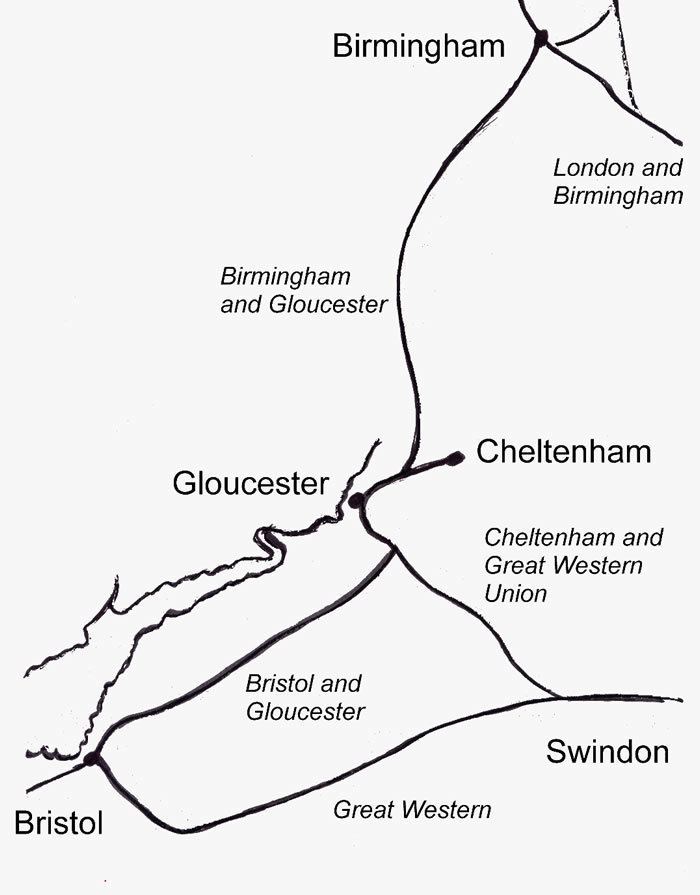Power type Steam Gauge 7 ft ⁄4 in (2,140 mm) | Driver dia. 5 ft 0 in (1.524 m) | |
 | ||
Loco weight 17 long tons 10 cwt (39,200 lb or 17.8 t) | ||
The Bristol and Gloucester Railway opened in 1844 between Bristol and Gloucester, meeting the Birmingham and Gloucester Railway. It is now part of the main line from the North-East of England through Derby and Birmingham to the South-West.
Contents
History
In the early nineteenth century, Bristol was an important port. In 1824 a meeting was held at the White Lion Inn in Bristol to discuss the idea of a railway to be known as the Bristol, Northern and Western Railway. This was the period around the opening of the Stockton and Darlington Railway in 1825, when many ambitious schemes were being floated, between London and Bristol and Birmingham and also the East Midlands.
Although there was a great deal of initial enthusiasm, there were technical difficulties and a financial crisis, and the plans were never carried through. Towards the end of the decade the country was in an economic recession, but two horse-drawn tramways were built, between 1832 and 1835, the Avon and Gloucestershire Railway and the Bristol and Gloucestershire Railway. These were locally known as The Coalpit Heath Dramway, serving among others, the Ram Hill Colliery.
In spite of the problems, interest remained high. Through the 1830s lines were in active construction, not only the Birmingham and Gloucester, but others from Birmingham through the Midlands to Yorkshire. A railway would give access to the coal and minerals - and the manufactured riches - of the North, and provide an export outlet for Birmingham through the port of Bristol.
In 1839 the Bristol and Gloucester Railway Bill was passed by Parliament. At Gloucester it formed a junction with the 7 ft 1⁄4 in (2,140 mm) broad gauge Cheltenham and Great Western Union Railway running into the town on mixed gauge tracks. The Bristol and Gloucester Railway had itself been built as broad gauge, but was narrowed to 4 ft 8 1⁄2 in (1,435 mm) standard gauge and the rolling stock sold to Thomas Brassey for use on the North Devon Railway.
In 1844 the Bristol and Gloucester merged with Birmingham and Gloucester Railway to form the short-lived Birmingham and Bristol Railway, becoming a pawn in railway politics between the Midland Railway and the Great Western Railway. In 1877 the joint Great Western and Midland Clifton Extension Railway in Bristol gave access to Avonmouth Docks, providing the docks with a route to the midlands.
The line remains part of one of the UK's important routes. The Midland Railway later became part of the London, Midland and Scottish Railway in the rationalisation of 1923. The LMS, along with the rest of the UK's mainline railways, became part of British Railways when it was nationalised in 1948. Today it carries a frequent service of long-distance intercity trains from the Scotland & the Northeast or Manchester Piccadilly to Bristol and beyond (mainly Plymouth & Penzance) and local stopping services between Worcester, Cheltenham Spa, Gloucester & Westbury/Weymouth via Bristol.
However the section between Yate and Bristol through Mangotsfield is closed. It was due to close on 3 January 1970, but in fact closed a week early after a landslip blocked the line at Staple Hill. Traffic now diverts at Westerleigh Junction and passes through Bristol Parkway and Filton (as shown on diagram).
Locomotives
The broad gauge locomotives that operated this line carried up to four different numbers during the ten years or so that they were running. The first number (in the series 1 - 11) was given by Stothert and Slaughter who were contracted to operate the railway.
Although the Midland Railway (MR) purchased these eleven locomotives from the contractors in July 1845, and absorbed the Bristol & Gloucester Railway (and the Birmingham & Gloucester Railway) on 3 August 1846, the locomotives were not given MR numbers until February 1847, when they became nos. 260–270. They were twice renumbered by adding 100 to their number in June 1852 and again in September 1853. Eight of the locomotives (B&GR nos. 1, 3 & 7 excepted) were sold by the MR to Thomas Brassey, who had secured the contract for working the North Devon Railway from 28 July 1855. That railway was absorbed by the London and South Western Railway (LSWR) on 1 January 1865; although none of the engines gained LSWR numbers, they remained in service a few more years, one of them as late as April 1877.
Bristol and Gloucester 2-4-0
These were intended for goods traffic. The locomotives were built at Stothert and Slaughter's workshops in Bristol using parts supplied by Bury, Curtis, and Kennedy.
Bristol and Gloucester 2-2-2
These locomotives were built at Stothert and Slaughter's workshops in Bristol using parts supplied by Bury, Curtis, and Kennedy. |}
Bristol and Gloucester 0-6-0
These were supplied by the Vulcan Foundry.
Midland Railway 2-2-2
These locomotives were renumbered into the 200, 300, then the 400 series before being converted to 4 ft 8 1⁄2 in (1,435 mm) standard gauge in 1854.
Midland Railway 0-6-0
These locomotives were renumbered into the 300, then the 400 series before being converted to 4 ft 8 1⁄2 in (1,435 mm) standard gauge in 1854.
